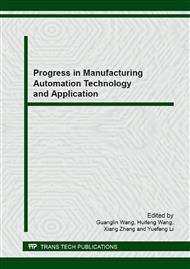p.804
p.808
p.813
p.818
p.823
p.831
p.835
p.841
p.845
Study on Small Power BLDCM Drive System
Abstract:
According to the voltage balance equation, the paper deduces the mathematical model of BLDCM on the basis of analyzing the operation principle. In SIMULINK environment, the BLDCM ontology module is built by adopting the combination of BLDCM state equation with S function method. The built motor ontology module proves to be accurate and reasonable through the analysis of the simulation waveform, which helps to analysis BLDCM electronic commutation, etc. Again taking LM621N as commutation control chip, using PIC microcontroller output variable frequency square wave, and through external input device to adjust the square wave frequency, thus realizes the control of motor speed. A brushless dc motor drive with circuit protection functions is designed by the method of combining hardware and software. Not only the motor work situation of ontology is intuitively reflected, and the development cycle is shorted.
Info:
Periodical:
Pages:
823-828
Citation:
Online since:
September 2013
Authors:
Keywords:
Price:
Сopyright:
© 2014 Trans Tech Publications Ltd. All Rights Reserved
Share:
Citation:


